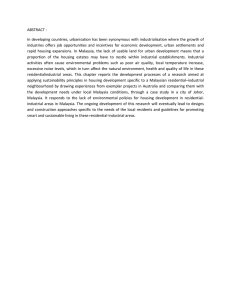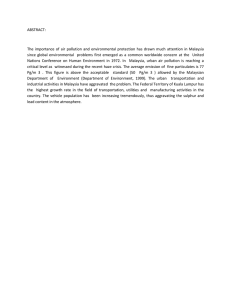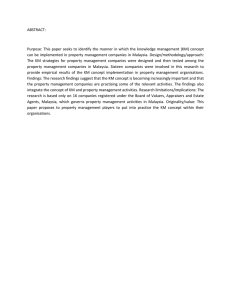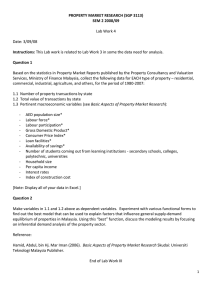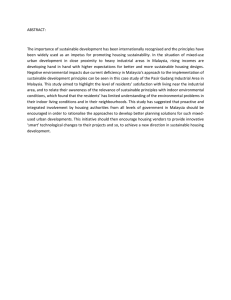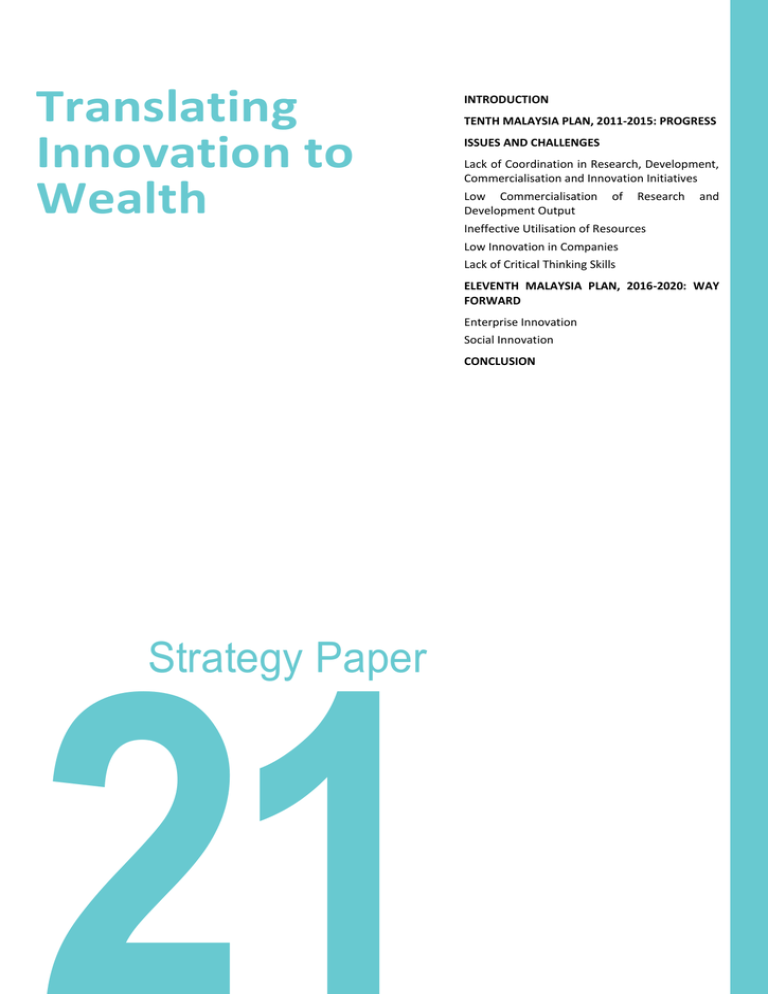
Translating
Innovation to
Wealth
INTRODUCTION
TENTH MALAYSIA PLAN, 2011-2015: PROGRESS
ISSUES AND CHALLENGES
Lack of Coordination in Research, Development,
Commercialisation and Innovation Initiatives
Low Commercialisation
Development Output
of
Research
and
Ineffective Utilisation of Resources
Low Innovation in Companies
Lack of Critical Thinking Skills
ELEVENTH MALAYSIA PLAN, 2016-2020: WAY
FORWARD
Enterprise Innovation
Social Innovation
CONCLUSION
Strategy Paper
For further information refer to:
Director General
Economic Planning Unit
Prime Minister’s Department
Block B5 & B6
Federal Government Administrative Centre
62502 Putrajaya
MALAYSIA
http://www.epu.gov.my
Tel.: 603-8000 8000
Fax.: 603-8888 3755
_____________________________________________
Publisher’s Copyright ©
All Rights Reserved. No part of this publication may be reproduced, stored in a retrieval system or transmitted
in any form or by any means electronic, mechanical, photocopying, recording and/or otherwise without the
prior permission of the Economic Planning Unit, Prime Minister’s Department.
Eleventh Malaysia Plan
Strategy Paper 21: Translating Innovation to Wealth
I.
21-1
INTRODUCTION
21.1 Innovation is a key driver to create new opportunities that derive greater value for
society both economically and socially. It is a process that involves deliberate application of
information, imagination and initiative in translating ideas or inventions into goods or
services. Innovation is a critical element of Malaysia’s development agenda as it raises
productivity and competitiveness to be an advanced and inclusive nation. Several measures
were undertaken to strengthen the innovation ecosystem during the Tenth Malaysia Plan,
2011-2015, including investing substantially in research, development, commercialisation
and innovation (R&D&C&I). Malaysia ranked 33rd out of 143 countries on the Global
Innovation Index (GII), 2014. However, the outcomes and return on investment in R&D&C&I
need to be further improved.
21.2 The Eleventh Malaysia Plan, 2016-2020, will address areas of weakness and push for
greater innovation as well as increase the return on investment on R&D&C&I by exploring
new approaches. Focus will be given to strengthening relational capital, which refers to
fostering stronger linkages, collaboration and trust among stakeholders. Stronger relational
capital will break down silos and reinforce collaboration between government research
institutes (GRIs), institutions of higher learning (IHLs), the government and industry.
Strategies will be targeted at two levels - the enterprise and society with the aim of
translating innovation to wealth.
II.
TENTH MALAYSIA PLAN, 2011-2015: PROGRESS
21.3 During the Tenth Plan, a series of actions to strengthen the innovation ecosystem
were undertaken along four key areas:
Shaping a supportive ecosystem by creating enabling environment for stakeholders
to carry out innovation activities;
Creating opportunities by providing incentives and investment opportunities through
public procurement;
Putting innovation enablers in place by strengthening the institutional structure and
Intellectual Property (IP) regime; and
Providing funds for research, development and commercialisation (R&D&C)
initiatives.
Eleventh Malaysia Plan
21-2
Strategy Paper 21: Translating Innovation to Wealth
21.4 These initiatives have resulted in the increase of innovation as reflected in the Global
Competitiveness Index (GCI) where in 2014-2015, Malaysia ranked 20th out of 144 countries
as compared to 24th out of 133 countries in 2009-2010. Meanwhile, the GII has ranked
Malaysia at 33rd out of 143 countries in 2014 as compared to 28 th out of 132 countries in
2009-2010. The GII and GCI rankings featuring selected indicators are as shown in
Exhibit 21-1.
Exhibit 21-1
International Ranking on Competitiveness and Innovation
Index
Global
Competitiveness
Index (GCI)
Indicators
Overall
Strength
Weakness
Global Innovation Overall
Index (GII)
Strength
Weakness
Government procurement of
advanced hi-tech products
Capacity on innovation
Company spending on Research
and Development
University & industry
collaboration
Patent Corporation Treaty (PCT),
patents, applications / million
populations
Quality of scientific research
institutions
Market sophistication
Business sophistication
Institution
Knowledge and technology
outputs
Creative outputs
Ranking
Ranking
2009-2010
24/133
9
2014
20/144
3
25
19
13
9
22
12
29
32
28
20
2009-2010
28/132
5
26
42
23
2014-2015
33/143
17
29
50
39
52
39
Source: World Intellectual Property Organisation and World Bank
21.5 The gross expenditure on research and development (GERD) as percentage of gross
domestic product (GDP) increased from 1.07% in 2010 to 1.13% in 2012. The research and
development (R&D) expenditure by business enterprises (BEs) of GERD, which were mainly
multinational companies (MNCs) and large domestic companies, increased from 56.7% in
2011 to 64.4% in 2012. This is still lower when compared to other nations such as 76.5% in
Japan, 75.7% in People’s Republic of China (PRC) and 75.4% in South Korea in 2011. The
ratio of research scientists and engineers (RSEs) per 10,000 labour force has also increased
from 53.1 in 2010 to 57.5 in 2012, as shown in Exhibit 21-2.
Eleventh Malaysia Plan
Strategy Paper 21: Translating Innovation to Wealth
Exhibit 21-2
Major Indicators for R&D, 2010-2012
2010
2011
RM bil.
%
RM bil.
%
R&D Expenditure by Sector
Government Research Institutes (GRIs)
Institutions of Higher Learning (IHLs)
Total GRIs and IHLs
Business Enterprises (BEs)
Total
GERD/GDP (%)
Human Resource in R&D
Total Headcount of R&D Researchers
Total Headcount of R&D Technicians &
Supporting Staff
Total Headcount of R&D Personnel
Total Full-Time Equivalent (FTE) of R&D
Personnel
Total FTE of Researchers
FTE per R&D Personnel
FTE per Researcher
Researchers per 10,000 Labour Force
Type of Research (Expenditure)
Basic Research
Applied Research
Experimental Research
Total
0.52
2.46
2.98
5.53
8.51
1.07
6.0
29.0
35.0
65.0
100
1.36
2.72
4.08
5.34
9.42
1.07
14.4
28.9
43.3
56.7
100
2012
RM bil.
%
0.73
3.04
3.77
6.84
10.61
1.13
67,412
20,902
73,752
23,209
75,257
28,729
88,314
50,484
96,961
57,405
103,986
62,807
41,253
0.57
0.61
53.08
RM
billion
1.52
5.80
1.19
8.51
47,242
0.59
0.64
58.07
RM
billion
1.62
6.26
1.54
9.42
52,052
0.60
0.69
57.45
RM
billion
3.66
5.36
1.59
10.61
%
17.9
68.2
13.9
100
%
17.2
66.4
16.4
100
21-3
6.9
28.7
35.6
64.4
100
%
34.5
50.5
15.0
100
Source: Malaysia Science and Technology Information Centre (MASTIC)
21.6 As part of the agenda to promote innovation activities across all sectors of the
economy, several measures were undertaken by the Government which included:
Establishing specialised agencies to drive the innovation programmes such as the
Agensi Inovasi Malaysia (AIM), National Science and Research Council (NSRC) and
Yayasan Inovasi Malaysia (YIM);
Implementing higher order thinking skills (HOTS) programmes in schools and tertiary
institutions to inculcate creative thinking culture;
Catalysing commercialisation via Khazanah Harta Intelek Malaysia, a centralised
repository on IPs arising from Government research programmes;
Setting up PlaTCOM Ventures Sdn. Bhd. (PlaTCOM) and Steinbeis Malaysia
Foundation (Steinbeis) to enhance collaboration and provide advisory services to
both researchers and companies, that is connecting knowledge creators and those
who need the knowledge; and
Eleventh Malaysia Plan
Strategy Paper 21: Translating Innovation to Wealth
21-4
Implementing online programmes such as UReka and GIGIH to provide open
innovation platforms where people were given the opportunity to share ideas, seek
expertise, form collaborative teams and attract funders and customers as well as
generate additional income through proven innovative and sustainable business
models.
21.7 Private entities and non-governmental organisations (NGOs) were also involved in
programmes to support innovation such as:
The Young Enterprise Programme, by the American-Malaysian Chamber of
Commerce (AMCHAM), involved selected secondary school students forming a ‘mini
company’ which exposed them to the complete business cycle, beginning from
capitalisation to voluntary liquidation. From 2011 to 2014, about 3,600 students
benefitted from this programme; and
Entrepreneurship programmes by the Enactus Malaysia Foundation, an international
non-profit organisation, brought together students, academics and business leaders
to use the power of entrepreneurial action to improve the quality of life and
standard of living for people in need was implemented. The experiences gained
helped participants develop their leadership and entrepreneurship skills. In 2012, 36
teams comprising 2,047 participants were involved in various community projects
benefitting 99,515 people.
III.
ISSUES AND CHALLENGES
21.8 There are several areas of weakness in innovation ecosystem that need to be
addressed. These include lack of coordination in the implementation of science and
technology policies, lack of industry and society linkages to universities and GRIs as well as
insufficient transfer of technology and technical spillover from foreign to domestic firms.
21.9 As measured by the Conference Board of the World Bank, Malaysia was in the
efficiency stage for 19 years before it graduated to the current transition stage. Malaysia
needs to move to the innovation-driven stage to become an advanced nation. The issues
and challenges hampering innovation are as follows:
Lack of coordination in R&D&C&I initiatives
Low commercialisation of R&D output
Ineffective utilisation of resources
Low innovation in companies
Lack of critical thinking skills
Eleventh Malaysia Plan
Strategy Paper 21: Translating Innovation to Wealth
21-5
Lack of Coordination in Research, Development, Commercialisation
and Innovation Initiatives
21.10 The Public Research Asset (PRA) Evaluation Performance Study, 2013, by NSRC
highlighted lack of coordination in R&D&C&I initiatives. Currently, there are 44 agencies
under ten ministries engaged in these initiatives. This has resulted in competition for
resources as well as overlapping and conflicting priorities in some research areas. As a
result, GRIs and IHLs are unable to build and maintain their core R&D capabilities in areas of
strategic importance.
21.11 The PRA study also highlighted the lack of an effective monitoring and evaluation
mechanism to track the progress of these initiatives as well as their impact on completion.
In line with efforts to strengthen the feedback mechanism, a multi-agency taskforce known
as Jawatankuasa Pelaburan Dana Awam (JKPDA) was established in 2013 to act as a
technical evaluation committee for R&D&C&I project funding. In 2014, out of 126 R&D&C&I
project proposals submitted, 34 were rejected either due to duplication, were not in line
with the national priority areas, or should be implemented in collaboration with other
agencies.
21.12 With respect to social innovation1, uncoordinated efforts and lack of a structured
framework are key constraints, where most programmes are conducted in silo. There are
1,200 social NGOs and 70 social enterprises (SEs), in addition to government agencies that
are delivering social interventions independently. Many of these NGOs and SEs have limited
funding to undertake their programmes. Many corporations also undertake social services
as part of corporate social responsibility for branding and advertising purposes. While the
number of programmes are large, their impact is small.
21.13 Social innovation programmes by YIM, Women in Innovation (WIN) and AIM are
conducted in silo. Due to weak linkages and collaboration, the dissemination of information
about these programmes is limited and uncoordinated resulting in a large portion of target
groups, especially in rural areas, unaware of the programmes.
1
Social innovation is often presented as a way to increase the quality of social services and their cost-effectiveness by offering equivalent
outcomes despite considerable budget constraints or using the same amount of budget. The innovation can take place within/from
government, third sector or in spaces between them.
Eleventh Malaysia Plan
Strategy Paper 21: Translating Innovation to Wealth
21-6
Low Commercialisation of Research and Development Output
21.14 GERD increased from RM8.5 billion in 2010 to RM10.6 billion in 2012. Despite
continuous increase in funding, the return on investment is still low. Commercialisation of
research output by IHLs and GRIs are low as most R&D projects are supply-driven and the
IPs generated not demanded by industry. The National Survey of Research and
Development 2013, by Malaysia Science and Technology Information Centre (MASTIC)
revealed that 7,899 IPs were filed in 2012 but the revenue generated was only RM1.6
million as compared to 464 IPs by BEs that generated RM15.4 million, as shown in Exhibit
21-3. Generally, researchers conducting public funded R&D projects focus on publishing
scientific journals and the creation of IPs, while efforts to commercialise is minimal.
Exhibit 21-3
Types of Research and IP Generation
Types of Research
2010 (%) 2012 (%)
GRIs and IHLs
43.6
34.9
Basic
11.63
11.2
Experimental
44.8
53.9
Applied
BEs
4.1
34.2
Basic
15.1
17.2
Experimental
80.0
48.6
Applied
Intellectual Properties
2012
GRIs and IHLs
7,899
number of IPs produced
1.62
commercialisation value (RM million)
BEs
464
number of IPs produced
15.41
commercialisation value (RM million)
Source: Malaysia Science and Technology Information Centre (MASTIC)
Ineffective Utilisation of Resources
21.15 GRIs and IHLs spend about RM3 billion annually on R&D projects, including the
acquisition of facilities and equipment. However, the utilisation rate of these equipment is
categorised as moderate and low among IHLs, and research institutions, as shown in Exhibit
21-4. In addition, there is also a lack of collaboration between government agencies and
companies, particularly small and medium enterprises (SMEs). This collaboration is crucial as
SMEs generally cannot afford R&D activities due to the high cost of equipment.
Eleventh Malaysia Plan
Strategy Paper 21: Translating Innovation to Wealth
Exhibit 21-4
Utilisation Rate of Science and Technology Equipment, 2012/2013
Total
Total Cost of
Item
Number of
%
Equipment
Source of
Equipment
(RM million)
funding
Public
1,479
76.8
1,215.99
Private
418
21.7
482.18
Joint Public-Private
13
0.7
8.89
International
15
0.8
9.73
Total
1,925
100
1,716.78
Level of usage of Equipment According to Respondents
Respondents
High Usage (%)
Moderate Usage (%)
Institutions of Higher
39.6
41.6
Learning
Government Agencies
57.2
22.5
Research Institutions
35.7
28.1
Government-linked and
27.4
65.6
Private Firms
Hospitals
46.3
50.3
21-7
%
70.8
28.1
0.5
0.6
100
Low Usage (%)
18.8
20.3
36.2
7.0
3.4
Source: Malaysia Science and Technology Information Centre (MASTIC)
Low Innovation in Companies
21.16 Expenditure by companies on R&D is still low despite high awareness on the
importance of innovation. The study on Technological Innovation Capabilities of MalaysianOwned Companies (MyTIC), 2012, by Malaysia Productivity Corporation (MPC) indicated
that 77% of SMEs spend RM100,000 or less a year on R&D. Only 27% of large companies and
10% of medium-sized companies spend RM1 million or more a year. The top 30 local
conglomerates by market capitalisation spend an average 0.3% of their annual revenue on
R&D. Meanwhile, the OECD Reviews of Innovation Policy in Southeast Asia, 2013, also
reported that, on average only 5.5% of companies in Malaysia actively participate in R&D
activities involving mostly the MNCs.
21.17 The low expenditure on R&D has hampered the capability and capacity of
companies, particularly SMEs, to innovate. In addition, companies perceive innovation
activities as high cost and high risk with uncertain demand, as shown in Exhibit 21-5. This
lack of innovative capability of SMEs has also hindered collaborations with MNCs and large
companies and transfer of technology and technical spillovers. MNCs in Malaysia sourced
less than 40% of their inputs from domestic companies. The MyTIC indicated that most
companies are adopters and adapters rather than creators of technology with 52% of
companies in adapter category, 36% adopter and only 6% creators.
Eleventh Malaysia Plan
Strategy Paper 21: Translating Innovation to Wealth
21-8
Exhibit 21-5
Factors Hampering Innovation Activities
Manufacturing
Services
Sector
Sector
Relative Factors Hampering Innovation Activities
(Scale 0-3)
0 – Not Relevant; 3 – Highly Relevant
Cost Factors
Market
Factors
Organisational
Factors
Cost too high
Lack of funds within the organization
Excessive perceived risk
Uncertain demand for innovative goods
and services
Attitude of personnel towards change
Attitude of managers towards change
2.16
1.93
1.65
1.74
1.71
1.51
1.81
1.30
1.66
1.59
1.54
1.32
Source: Malaysia Science and Technology Information Centre (MASTIC)
Lack of Critical Thinking Skills
21.18 Substantial investments have been made in education but the quality of graduates
does not match industry needs as indicated by several international reports. The current
ratio of students in Science, Technology, Engineering and Mathematics (STEM) and nonSTEM education is 42:58 compared with the target of 60:40. In 2012, Malaysia was ranked
52nd out of 65 participating countries in the Programme for International Student
Assessment (PISA), with mean scores below the global average. STEM ratio and PISA
findings indicate that significant efforts are required to achieve the targeted number of RSEs
of 70 per 10,000 labour force by 2020 compared with the current ratio of 57.5 per 10,000
labour force.
21.19 There is a lack of soft skills among students such as critical thinking, communications,
innovation, teamwork and leadership. This has partly contributed to the mismatch between
the requirements of the labour market and the skills of job seekers, as shown in Exhibit 216. With the transition towards an economy that is driven by high value and knowledge
intensive activities, the jobs created will require higher order thinking skills, as shown in
Exhibit 21-7.
Eleventh Malaysia Plan
Strategy Paper 21: Translating Innovation to Wealth
21-9
Exhibit 21-6
Malaysian Firms’ Skills Requirement Constraint and Lack of Skills Leads to Job Vacancies, 2009
Source: World Bank: Malaysia Economic Monitor, 2012
Exhibit 21-7
Jobs Creation in Malaysia, 2001-2010
Source: World Bank: Malaysia Economic Monitor, 2012
Eleventh Malaysia Plan
Strategy Paper 21: Translating Innovation to Wealth
IV.
21-10
ELEVENTH MALAYSIA PLAN, 2016-2020: WAY FORWARD
21.20 The Eleventh Plan will focus on translating innovation to wealth through
strengthening relational capital to foster stronger linkages, collaboration and trust among
stakeholders. Stronger relational capital will improve coordination and enable the sharing
and testing of ideas across multiple stakeholders and disciplines, thus improving the
national innovation ecosystem to enable Malaysia to bring creative outputs to market and
share resources. Strategies will be undertaken at both the enterprise and societal levels to
sustain economic growth and improve wellbeing.
Enterprise Innovation
Targets
21.21 The targets set for enterprise innovation are as shown in Exhibit 21-8.
Exhibit 21-8
Achievements and Targets for Enterprise Innovation
Indicator
2010
Ratio of business and Government expenditure on R&D
65:35
GERD/GDP (%)
1.07
Ratio of researchers/10,000 labour force
53.1
Commercialisation rate of R&D outputs by:
IHLs (%)
3.4
5.5
MOSTI R&D Fund (%)
2012
64:36
1.13
57.5
2020
70:30
2.0
70.0
2.11
3.11
5.0
10.0
1
Note: data as of 2013
Source: Malaysia Science and Technology Information Centre (MASTIC) and Ministry of Education
Strategies
21.22 Efforts to enhance innovation at the enterprise level are based on four strategies,
namely:
Strengthening the governance mechanism by creating a research management
agency (RMA) and expanding the 1Dana Portal;
Enhancing demand-driven research by streamlining public sector funding for
R&D&C&I;
Strengthening industry-academia collaboration through intermediaries by
encouraging local and international collaborations for technology transfer, including
strategic alliances between MNCs and SMEs; and
Eleventh Malaysia Plan
Strategy Paper 21: Translating Innovation to Wealth
21-11
Promoting private financing of research, development, commercialisation and
innovation by increasing access to private sources of financing, and developing a
framework for risk mitigation and management of crowdfunding activities.
Initiatives to support these strategies are as shown in Exhibit 21-9.
Exhibit 21-9
Strategy Canvas for Enterprise Innovation
Strengthening the Governance Mechanism
Establishment of Research Management Agency
21.23 An existing agency will be restructured to become the RMA to strengthen the
institutional mechanism to manage public R&D&C&I initiatives to improve effectiveness,
maximise outcome and increase return on investment. In addition, the agency will also
review existing programmes to eliminate those which are overlapping and supply-driven
and reduce low-impact programmes.
Eleventh Malaysia Plan
Strategy Paper 21: Translating Innovation to Wealth
21-12
21.24 The structure of the RMA is as shown in Exhibit 21-10 and the role of the RMA is as
follows:
Conduct studies on technology foresight and market trends in setting the national
priority areas for R&D;
Act as a clearing house to ensure project proposals are in line with the national
priority areas;
Foster interdisciplinary and multi-agency research efforts, enable researcher mobility
as well as allow the development of competitive and collaborative R&D;
Maintain the 1Dana portal as a centralised one-stop online repository for R&D&C&I
projects containing information on output, facilities and equipment, experts and
field of expertise; and
Monitor and evaluate the progress and impact of R&D&C&I projects and the
information to be used as feedback for continuous improvement.
Exhibit 21-10
Structure of Research Management Agency
National Priority
Clearing House
Areas
• Fundamental
• Coordinate all
research:
public funded
knowledge
R&D&C&I
• Priority research:
projects, to
national
ensure effective
problems
and efficient
• Strategic
utilisation of
Research: new
public funds
industry
• Demand-driven
research:
company
solutions
Source: Economic Planning Unit
Registry
1DANA
• Facilities
• Outputs /
Findings
• Experts/
Expertise
• Projects
• centralised onestop online
repository for
lists of R&D&C&I
projects and
their outputs,
facilities &
equipment; and
expert & their
field of expertise
Monitoring and
Evaluation
• Targets
• Evaluate
outcomes of
R&D&C&I
initiatives
• Monitor progress
of
implementation
• Assess indicators
of achievement
Eleventh Malaysia Plan
Strategy Paper 21: Translating Innovation to Wealth
21-13
Sharing of resources
21.25 The 1Dana portal, established in 2014, will be expanded to serve as a centralised
registry for R&D&C&I-related information to encourage sharing of resources and
programmes. This will include information on R&D facilities and equipment, expertise in
various fields, research output and IPs. Through this portal, owners of R&D capital will be
able to maximise the use of their facilities and equipment, and also, increase their income
through the pay-per-use approach. In addition, companies will have access to these
resources without incurring large capital outlays and will be able to upgrade, test and certify
their products to meet international standards. Information from other related portals such
as krste.my, TECHMart database and myren.net.my, will be integrated with the 1Dana
portal for better outreach.
Promoting innovative corporate culture
21.26 Innovation also needs to be embedded into the corporate culture to enable
companies to gain competitive advantage and be sustainable. Support will be given to midlevel and large companies to enable them to move to the next level and capture return on
innovation via programmes such as the National Corporate Innovation Index (NCII), Mid-Tier
Companies Development Programme (MTCDP) and the Intellectual Capital Future Check
(ICFC). The adoption of NCII will enable companies to measure innovation and translate it
into financial returns, while the MTCDP helps local mid-tier companies in Malaysia to
strengthen their core business functions and to accelerate their export growth. Through the
ICFC, companies will be able to deliver structured reports on intangible assets such as tacit
knowledge, IPs and networking to financial institutions leading to increase their credit
worthiness.
Enhancing Demand-driven Research
21.27 Public sector funding for R&D&C&I projects will be streamlined to ensure better
returns. Funding will be targeted at national priority areas which have been identified to
drive economic growth. The centralised mechanism managed by RMA will coordinate
research to reduce duplication, increase synergy and channel funding into fundamental,
applied and demand-driven research, as shown in Exhibit 21-11. In this regards, emphasis
will be given to applied research and demand-driven research to promote strategic
partnerships between companies and researchers, and generate higher return on
investment, as follows:
Eleventh Malaysia Plan
Strategy Paper 21: Translating Innovation to Wealth
21-14
Applied research
o
Priority research is to solve national issues such as climate change,
communicable diseases and water scarcity. This is expected to improve social
well-being; and
o
Strategic research is for a longer term solution to identify new products and
services for the market as well as to develop new industries. The outcome is
expected to generate economic growth.
Demand-driven research will be implemented through strategic partnership basis
between companies and researchers to solve specific problems within stipulated
time at lower cost. Intermediaries will facilitate companies to connect to the right
expertise. This is expected to improve productivity and competitiveness of the
companies and higher commercialisation rate of R&D
Exhibit 21-11
Centralised R&D&C&I Mechanism
Source: Economic Planning Unit
Eleventh Malaysia Plan
Strategy Paper 21: Translating Innovation to Wealth
21-15
Strengthening Industry - Academia Collaboration through Intermediaries
21.28 Creation of new products or processes require continuous R&D and innovation. The
Government has established new intermediaries namely Steinbeis, SIRIM- Fraunhofer and
PlaTCOM to encourage companies to innovate and improve their market competitiveness
and productivity. The details of the newly established intermediaries are as shown in Box
21-1. These intermediaries will complement existing agencies such as Malaysian Technology
Development Corporation (MTDC), Collaborative Research in Engineering Science and
Technology (CREST) Centre, and Aerospace Malaysia Innovation Centre. These industry-led
intermediaries will continue to facilitate companies to source for the right researchers to
provide solutions in terms of technology, process and business model improvements. This
strategic alliance will accelerate sharing of knowledge and innovative ideas and improve
company competitiveness.
21.29 The Public Private Research Network (PPRN), in the Ministry of Education (MoE), will
connect industries to researchers in universities to conduct contract research. In addition,
the Health Technopolis initiative to attract a cluster of healthcare firms and researchintensive companies to locate within Universiti Kebangsaan Malaysia’s (UKM) campus to
foster demand-driven research will be led by UKM. Guidelines will be formulated for
researchers in areas such as remuneration, use of universities’ facilities and equipment and
IP ownership. The intermediaries’ scope of work is as shown in Exhibit 21-12.
All economic sectors
All economic sectors
• Local
Universities
• SMEs
• SMEs,
• IHLs/ GRIs,
• individual
inventors
• E&E
companies
PPRN
PlaTCOM
Source: Economic Planning Unit
CREST
•
•
•
•
•
All companies
/business
entities
Steinbeis
E&E
Demand-driven Research
• Part -Financing projects
• Connect firms to researchers
• Contribute facilities to applied research
Demand-driven Research
• End-to-end facilitation from concept to
commercialisation, IP protection, capacity
building & advisory services
Demand-driven Research
Strategic Research
• Matching grant (from
RM5,000 up to maximum
of RM100,000)
• Matching grant
• Government
• Industries
• Matching grants
(Government: RM30,000
maximum)
• Cost of services borne by
clients. (RM30,000RM50,000)
• Revenue generated will
fund Steinbeis
• Matching grants
(Government: 50-80%;
Industry: 20-50%)
• Soft loans
Funding Support
2-16
• Government
• Industries
• Government
• Industries
Demand-driven Research
• Product and process improvement
• Up-scaling and pilot production
• Training
• Technology audits
• Testing, inspection, certification and calibration
Applied Research (Priority/ Strategic Research)
Demand-driven Research
• Government
• Provide subject matter experts (local & foreign)
• Self generating
for business solution
income
• Steinbeis Network for market reach
• Train companies to attain international standards
Renewable energy
Energy storage
Medical devices
Automation
Industrial design
Machinery &
equipment
Healthcare
Nanotechnology
E&E
Palm Oil/Rubber
Telecommunications
•
•
•
•
•
•
SMEs in
manufacturing
sector
SIRIMFraunhofer
Source of
Funding
• Government
• Industry
• Regional
• International
Services rendered
Focus areas
Target groups
Intermediaries
Exhibit 21-12
Matrix Analysis of Intermediaries
Eleventh Malaysia Plan
Strategy Paper 21: Translating Innovation to Wealth
Eleventh Malaysia Plan
Strategy Paper 21: Translating Innovation to Wealth
2-17
Box 21-1
Scope of Intermediaries
The Public-Private Research Network (PPRN)
This initiative, introduced by MoE, in collaboration with MTDC and SME Corp, aims to connect
companies, especially SMEs, to researchers at the IHLs to provide solutions. It will be a catalyst for
innovation, knowledge-sharing and technological advancement for local companies.
PlaTCOM Ventures Sdn. Bhd.
PlaTCOM Ventures Sdn. Bhd. is the national technology commercialisation platform. It is a smart
partnership between AIM and SME Corp. The platform provides end-to-end facilitation services from
concept to commercialisation of innovation including access to funding, infrastructure, testing,
validation, regulatory certification, market intelligence, technical expertise and commercialisation
advisory.
Steinbeis Malaysia Foundation
The Steinbeis Malaysia Foundation aims to connect academia to industry and promote effective and
efficient cooperation in knowledge and technology transfers. It will enable academics and scientists
to set up ‘mini-entities’ or ‘transfer centres’ to conduct short consultations, R&D and projects for
private entities, commonly SMEs but also larger companies and MNCs. It provides an innovative
platform for collaboration for business solutions and focuses on development of end products.
SIRIM-Fraunhofer Programme
SIRIM Fraunhofer Programme is a strategic collaboration with Fraunhofer Germany, which focuses
on technology penetration and upgrading, technology audit, technology commercialisation as well
as strengthening market access to boost productivity of SMEs. Through this programme, SMEs are
able to develop new products and processes, solve technological problems, automate and
mechanise their production processes, obtain new technologies and access calibration, testing and
certification services. The SIRIM Delivery Mechanism will identify industry problems through
technology audit or value chain analysis, industry engagement and direct enquiries. SIRIM will
customise solutions for the identified problems to enhance technology penetration and upgrading of
SMEs. The delivery of the services and KPIs will be monitored to ensure the success of the
programme.
Source: Ministry of Education, Agensi Inovasi Malaysia and SIRIM Berhad
Eleventh Malaysia Plan
Strategy Paper 21: Translating Innovation to Wealth
2-18
Promoting Private Financing of Research, Development, Commercialisation
and Innovation
21.30 Access to financing and assistance will be strengthened through continuous
engagement with private financial institutions, venture capitalists and angel investors to
widen financial options, reduce dependency on Government resources and increase the
financing of innovation projects. This includes the expansion of the Technology Park
Malaysia Angel Chapter and early stage financing for SMEs by the SME Investment Partner
programme. In addition, equity crowdfunding is an area that will be explored to widen the
range of fundraising and investment products, as well as improve market access to a
broader spectrum of issuers and investors. Crowdfunding is envisioned to provide financing
opportunities for SMEs, start-ups and innovative businesses seeking liquidity in a more
efficient and transparent manner. The enabling environment for innovation will be further
strengthened by providing a clear framework for risk mitigation and management.
Social Innovation
Strategies
21.31 Efforts to boost innovation at the societal level are based on three strategies,
namely:
Strengthening collaboration through whole-society approach by encouraging
broader participation across Government, residents, non-governmental
organisations (NGOs), organisational and community laeders for social services
delivery;
Developing a social financing model to promote investments from the private
sector, foundations and individuals in delivering social services; and
Promoting higher order thinking skills to develop a dynamic society by scaling up
existing programmes such as i-Think and Genovasi, prioritising science and
mathematics in education and expanding career opportunities in science and
technology.
The initiatives to support these strategies are as shown in Exhibit 21-13.
Eleventh Malaysia Plan
Strategy Paper 21: Translating Innovation to Wealth
2-19
Exhibit 21-13
Strategy Canvas for Social Innovation
Strengthening Collaboration through a Whole-society Approach
21.32 In increasing the impact of innovation at societal level, the design and delivery of
social services will shift from a top-down, government-centric approach to a whole-society
approach. This approach will strengthen relational capital in social services delivery, by
encouraging collaboration among Government, residents, NGOs, organisational and
community leaders to optimise utilisation of resources and promote volunteerism.
21.33 A special task force will be established comprising representatives from relevant
ministries, private sector, NGOs and community-based organisations (CBOs), to better
coordinate social service programmes. The task force will be supported with the relevant
expertise to provide advice on the implementation of programmes. Under this mechanism,
private sector, NGOs and CBOs will be involved in social services planning, design and
delivery, thus, reducing the current top-down approach. Through this task force, successful
community-based programmes will be replicated and the Government will assist in
improving the professionalism and capabilities of NGOs and CBOs by setting clear KPIs,
monitoring deliverables and evaluating outcomes as well as provide training, where
necessary. At the same time, the Government will focus on targeted support to NGOs and
private entities in social services delivery.
Eleventh Malaysia Plan
Strategy Paper 21: Translating Innovation to Wealth
2-20
Developing a Social Financing Model
21.34 In line with the whole-society approach, a social financing model to facilitate publicprivate partnership programmes will be developed to promote investments from the private
sector, foundations and individuals in delivering social services. Through this model, the
‘payment by results’ mode will be introduced, where private social impact investors will
provide funding for NGOs and CBOs to implement social services and will be reimbursed by
the Government when the agreed outcomes are achieved, as shown in Exhibit 21-14. This
model will reduce the burden and risk of social services programmes through the sharing of
resources and leveraging civil society's collective skills, enthusiasm and innovation capacity
with the Government as a facilitator. In addition, the involvement of NGOs and CBOs will
increase the flexibility in implementation of the programmes.
Exhibit 21-14
New Social Service Financing Model
Source: Economic Planning Unit
Promoting Higher Order Thinking Skills to Develop a Dynamic Society
21.35 Existing HOTS programmes, including i-Think and Genovasi, will be scaled-up to
inculcate the current and future workforce with critical thinking, communications and
leadership skills. In addition, science and mathematics in education will also be given
priority, in line with the National Education Blueprint, 2013-2025, as these subjects
stimulate creativity and innovation. Career opportunities in science and technology will be
expanded with the Government’s emphasis on knowledge intensive and high value added
industries. It is expected that HOTS will be expanded to 10,000 schools by 2020 involving
450,000 teachers and 5.2 million students.
Eleventh Malaysia Plan
Strategy Paper 21: Translating Innovation to Wealth
V.
2-21
CONCLUSION
21.36 Innovation is crucial for the development agenda to increase productivity and
improve competitiveness. In the Eleventh Plan, efforts will be undertaken to translate
innovation into new wealth for the nation. To achieve this, relational capital will be
strengthened to improve coordination and enable sharing and testing of new ideas.
Strategies will also be implemented to foster stronger linkages, collaboration and trust
among stakeholders at both the enterprise and societal levels to ensure continuous
innovation for new or improved products and processes, technologies and business models
to increase productivity and competitiveness of the nation.

